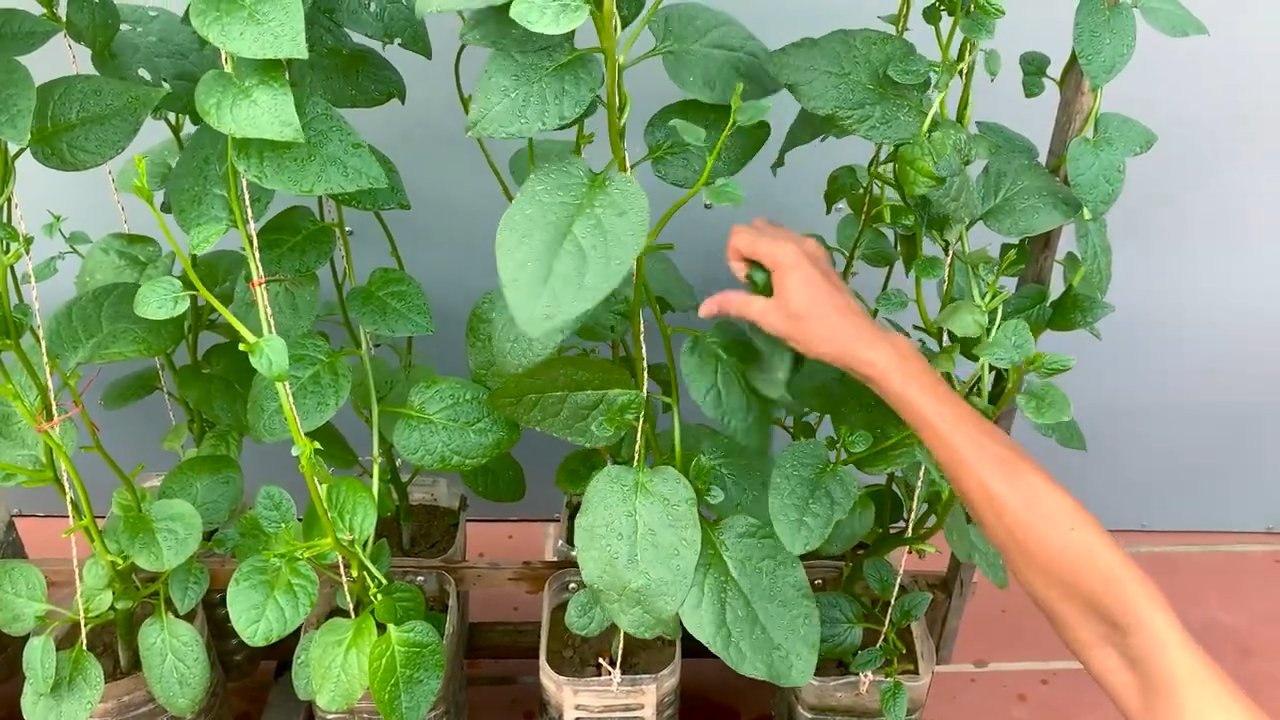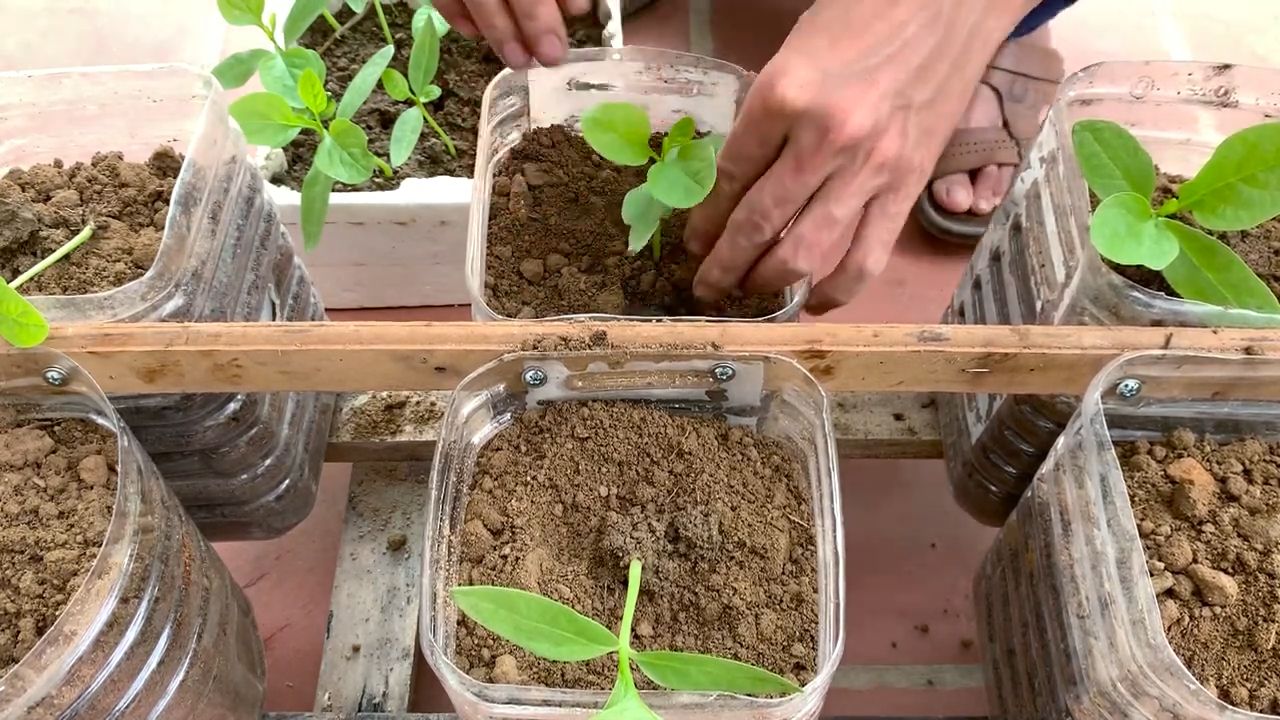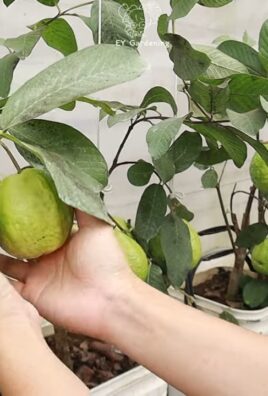Grow Spinach Year Round? Absolutely! Imagine fresh, vibrant spinach gracing your table no matter the season. No more relying on wilted supermarket greens or missing out on your favorite spinach recipes during the colder months. This isn’t just a dream; it’s an achievable reality with a few clever DIY tricks and hacks that I’m excited to share with you.
Spinach, a leafy green packed with nutrients, has been cultivated for centuries, with its origins tracing back to ancient Persia. It gradually made its way across the globe, becoming a staple in cuisines worldwide. From Popeye’s legendary strength to countless healthy salads, spinach has earned its place as a nutritional powerhouse. But what if you could bypass seasonal limitations and enjoy this versatile vegetable whenever you crave it?
That’s where these DIY home gardening tricks come in! Many gardeners struggle with the short growing season of spinach, often limited to spring and fall. This article will unlock the secrets to extending that season, allowing you to grow spinach year round, even in challenging climates. I’ll guide you through simple, cost-effective methods, from creating protective structures to selecting the right spinach varieties. Get ready to transform your garden and enjoy a constant supply of fresh, homegrown spinach!

Growing Spinach Year-Round: My Foolproof DIY Guide
Okay, spinach lovers, listen up! Are you tired of only enjoying fresh, vibrant spinach during the spring and fall? I was too! That’s why I embarked on a mission to grow spinach year-round, and guess what? I cracked the code! This guide is all about how I did it, and how you can too. It’s easier than you think, and the reward of having fresh spinach whenever you crave it is totally worth it.
Understanding Spinach’s Needs
Before we dive into the nitty-gritty, let’s quickly cover what spinach needs to thrive. Spinach is a cool-weather crop, meaning it prefers temperatures between 50°F and 70°F. Hot weather causes it to bolt (go to seed), making the leaves bitter and inedible. That’s why growing it in the summer can be tricky. But don’t worry, we’ll tackle that!
* Sunlight: Spinach needs at least 3-6 hours of sunlight per day.
* Soil: Well-draining, fertile soil with a pH between 6.5 and 7.0 is ideal.
* Water: Consistent moisture is key, but avoid overwatering.
* Temperature: As mentioned, cool temperatures are best. We’ll use tricks to manage this.
Phase 1: Spring and Fall Spinach Bonanza
These are the easiest times to grow spinach, so let’s maximize them!
1. Choose Your Spinach Variety: There are tons of spinach varieties, but some of my favorites for spring and fall are ‘Bloomsdale Long Standing’ (slow to bolt) and ‘Giant Nobel’ (large, tasty leaves). Look for varieties that are known for their bolt resistance.
2. Prepare the Soil: Amend your garden bed with compost or well-rotted manure. This will improve drainage and add essential nutrients. I usually dig in about 2-3 inches of compost.
3. Sow the Seeds: Plant spinach seeds about ½ inch deep and 1 inch apart in rows that are 12 inches apart. You can also broadcast the seeds and thin them later. I prefer rows for easier weeding.
4. Water Gently: Water the soil gently after planting to avoid disturbing the seeds. Keep the soil consistently moist but not soggy.
5. Thin Seedlings: Once the seedlings emerge (usually in about 5-10 days), thin them to about 3-4 inches apart. This gives them room to grow and prevents overcrowding.
6. Fertilize (Optional): If your soil is lacking nutrients, you can fertilize with a balanced organic fertilizer. I usually use a liquid seaweed fertilizer diluted according to the package instructions.
7. Harvest Regularly: Start harvesting spinach leaves when they are about 4-6 inches long. Cut the outer leaves, leaving the inner leaves to continue growing. This is called “cut and come again” harvesting, and it extends your harvest period.
Phase 2: Conquering Summer Spinach
This is where things get a little more challenging, but definitely doable! The key is to provide shade and keep the soil cool.
1. Choose Heat-Tolerant Varieties: ‘Malabar’ spinach isn’t technically a true spinach, but it tastes similar and thrives in hot weather. ‘New Zealand’ spinach is another good option. These are your best bets for summer harvests.
2. Plant in a Shady Location: Choose a spot in your garden that receives partial shade, especially during the hottest part of the day. Morning sun is ideal.
3. Use Shade Cloth: If you don’t have a naturally shady spot, you can use shade cloth to protect your spinach from the intense sun. I use a 30-50% shade cloth, depending on how hot it gets.
4. Mulch Heavily: Apply a thick layer of mulch (straw, wood chips, or shredded leaves) around your spinach plants. This will help keep the soil cool and retain moisture.
5. Water Deeply and Regularly: Water your spinach plants deeply and regularly, especially during hot, dry weather. Water in the morning to allow the foliage to dry before nightfall, which helps prevent fungal diseases.
6. Monitor for Bolting: Keep a close eye on your spinach plants for signs of bolting. If you see flower stalks starting to form, pinch them off to prolong the harvest.
7. Consider Succession Planting: Plant small batches of spinach every 2-3 weeks to ensure a continuous supply throughout the summer. Even with heat-tolerant varieties, the harvest window might be shorter.
Phase 3: Winter Spinach Protection
Extending the spinach season into winter requires protecting your plants from frost and freezing temperatures.
1. Choose Cold-Hardy Varieties: ‘Winter Bloomsdale’ and ‘Tyee’ are excellent choices for winter spinach. They are more resistant to cold temperatures.
2. Plant in a Protected Location: Plant your winter spinach in a location that is sheltered from wind and receives as much sunlight as possible.
3. Use Row Covers: Row covers are lightweight fabric covers that protect plants from frost and cold temperatures. I use them extensively in the winter. Simply drape the row cover over your spinach plants and secure it with stakes or rocks.
4. Build a Cold Frame: A cold frame is a simple structure that provides extra protection from the cold. You can build one out of wood, plastic, or even old windows. Place the cold frame over your spinach plants to create a mini-greenhouse.
5. Mulch Heavily: Again, mulch is your friend! A thick layer of mulch will help insulate the soil and protect the roots from freezing.
6. Water Sparingly: Water your spinach plants sparingly during the winter, as they don’t need as much water when it’s cold. Water only when the soil is dry to the touch.
7. Ventilate on Sunny Days: On sunny days, open the row covers or cold frame to allow for ventilation. This will prevent the plants from overheating and reduce the risk of fungal diseases.
Troubleshooting Common Spinach Problems
Even with the best care, you might encounter some problems. Here’s how I deal with them:
* Aphids: These tiny pests can suck the sap from spinach leaves. I control them by spraying the plants with a strong stream of water or using insecticidal soap.
* Slugs and Snails: These slimy creatures love to munch on spinach leaves. I use beer traps or diatomaceous earth to control them.
* Downy Mildew: This fungal disease causes yellow spots on the leaves. I prevent it by providing good air circulation and avoiding overhead watering. If it occurs, I remove the affected leaves and spray with a copper fungicide.
* Bolting: As mentioned earlier, bolting is when spinach goes to seed. Prevent it by choosing bolt-resistant varieties, providing shade, and watering regularly.
My Favorite Spinach Recipes
Now that you’re growing your own spinach, you’ll need some delicious recipes to use it in! Here are a few of my go-to’s:
* Spinach Salad with Warm Bacon Vinaigrette: A classic for a reason! The salty bacon and tangy vinaigrette perfectly complement the fresh spinach.
* Spinach and Artichoke Dip: This creamy, cheesy dip is always a crowd-pleaser.
* Spinach Smoothie: A healthy and delicious way to start your day. I add spinach to my smoothies with banana, berries, and almond milk. You can’t even taste the spinach!
* Sautéed Spinach with Garlic: A simple and flavorful side dish. Just sauté spinach with garlic and olive oil until wilted.
* Spinach and Feta Pie (Spanakopita): A savory Greek pie filled with spinach, feta cheese, and herbs.
Tips and Tricks I’ve Learned Along the Way
* Succession Planting is Key: I can’t stress this enough! Planting small batches of spinach every few weeks ensures a continuous harvest.
* Don’t Overwater: Overwatering can lead to root rot and other problems. Let the soil dry out slightly between waterings.
* Harvest in the Morning: Spinach leaves are at their freshest and most flavorful when harvested in the morning.
* Wash Spinach Thoroughly: Spinach can be sandy, so be sure to wash it thoroughly before using it. I use a salad spinner to remove excess water.
* Store Spinach Properly: Store spinach in a plastic bag in the refrigerator. It will last for several days.
Growing spinach year-round might seem daunting at first, but with a little planning and effort, it’s totally achievable. I hope this guide has inspired you to give it a try. There’s nothing quite like the taste of fresh, homegrown spinach! Happy gardening!

Conclusion
So, there you have it! Growing spinach year-round isn’t just a gardener’s dream; it’s an achievable reality with a little planning and the right techniques. We’ve explored the secrets to extending your spinach harvest far beyond the typical growing season, ensuring a constant supply of fresh, nutritious greens for your table. From understanding the nuances of seasonal planting to mastering protective measures against harsh weather, you’re now equipped with the knowledge to cultivate a thriving spinach patch, no matter the time of year.
The beauty of this DIY approach lies not only in its practicality but also in its adaptability. Feel free to experiment with different spinach varieties to discover which ones thrive best in your specific microclimate. Consider adding companion plants like radishes or lettuce to your spinach beds to deter pests and optimize space. You could even explore hydroponic or container gardening methods for an even more controlled environment, especially if you’re limited on outdoor space.
Don’t be afraid to get creative with your protective structures. While cold frames and row covers are excellent options, you can also repurpose materials you already have on hand. Old windows, plastic sheeting, or even discarded shower curtains can be transformed into effective barriers against frost and snow. The key is to provide insulation and protection while still allowing adequate sunlight and ventilation.
Remember, the journey of growing spinach year-round is a learning process. There will be successes and setbacks along the way. But with each attempt, you’ll gain valuable insights into your garden’s unique characteristics and refine your techniques accordingly. The reward, of course, is a continuous supply of delicious, homegrown spinach that’s far superior to anything you can find in the grocery store.
Why is this a must-try? Because fresh, homegrown spinach is packed with vitamins, minerals, and antioxidants, making it a nutritional powerhouse. Plus, the satisfaction of harvesting your own food, especially during the colder months, is simply unparalleled. Imagine adding vibrant green spinach to your winter salads, smoothies, or soups, knowing that it came straight from your garden.
We wholeheartedly encourage you to embark on this rewarding gardening adventure. Start small, experiment with different methods, and don’t be discouraged by initial challenges. The ability to grow spinach year-round is within your reach, and the benefits are well worth the effort.
Now, we want to hear from you! Have you tried growing spinach year-round? What techniques have worked best for you? What challenges have you encountered? Share your experiences, tips, and tricks in the comments below. Let’s create a community of spinach enthusiasts who are passionate about extending the growing season and enjoying the bounty of their gardens all year long. Your insights could inspire and empower other gardeners to achieve their own year-round spinach dreams. Let’s cultivate a thriving community of year-round spinach growers!
Frequently Asked Questions (FAQ)
Q: What is the best spinach variety to grow year-round?
A: While many spinach varieties can be grown year-round with proper protection, some are better suited for specific seasons. For fall and winter growing, consider cold-hardy varieties like ‘Winter Bloomsdale’, ‘Tyee’, or ‘Giant Winter’. These varieties are known for their ability to withstand freezing temperatures and continue producing even in challenging conditions. For spring and summer growing, opt for heat-tolerant varieties like ‘Malabar’ (though technically not true spinach, it’s a great substitute) or ‘Regiment’. These varieties are less likely to bolt (go to seed) in hot weather, ensuring a longer harvest. Experimenting with different varieties is key to finding what works best in your local climate.
Q: How do I protect my spinach from frost and freezing temperatures?
A: Protecting spinach from frost is crucial for year-round growing. Several methods can be employed, depending on the severity of the cold and your available resources. Cold frames are an excellent option for providing a sheltered environment for your spinach plants. These structures trap heat from the sun, raising the temperature inside and protecting the plants from freezing. Row covers, made from lightweight fabric, can also be used to insulate spinach plants. Simply drape the row cover over the plants, securing the edges with soil or rocks. For more severe cold, consider using a combination of methods, such as a cold frame with row covers inside. Mulching around the base of the plants with straw or leaves can also help insulate the soil and protect the roots.
Q: How often should I water my spinach in the winter?
A: Watering spinach in the winter requires a delicate balance. Overwatering can lead to root rot, especially in cold, damp conditions. However, underwatering can cause the plants to dry out and wither. The key is to water only when the soil is dry to the touch. Check the soil moisture level regularly, and water sparingly, usually only once every week or two, depending on the weather conditions. Water in the morning to allow the foliage to dry before nightfall, reducing the risk of fungal diseases. If you’re using a cold frame or row cover, be sure to ventilate it regularly to prevent excessive humidity.
Q: How do I prevent spinach from bolting (going to seed)?
A: Bolting is a common problem with spinach, especially in hot weather. When spinach bolts, it becomes bitter and unpalatable. To prevent bolting, choose heat-tolerant varieties for spring and summer growing. Provide shade during the hottest part of the day, using shade cloth or planting spinach in a location that receives afternoon shade. Water regularly to keep the soil consistently moist, as drought stress can also trigger bolting. Harvest spinach leaves regularly, as this encourages the plant to continue producing new growth rather than focusing on seed production.
Q: What are some common pests and diseases that affect spinach, and how can I control them?
A: Spinach can be susceptible to various pests and diseases, including aphids, leaf miners, and downy mildew. Aphids can be controlled with insecticidal soap or by introducing beneficial insects like ladybugs. Leaf miners can be managed by removing and destroying infested leaves. Downy mildew is a fungal disease that can be prevented by providing good air circulation, avoiding overhead watering, and using disease-resistant varieties. Crop rotation can also help prevent the buildup of soilborne diseases. Regularly inspect your spinach plants for signs of pests or diseases, and take action promptly to prevent them from spreading.
Q: Can I grow spinach indoors?
A: Yes, you can absolutely grow spinach indoors! In fact, indoor growing is a great way to ensure a year-round supply of fresh greens, especially if you live in a climate with harsh winters. To grow spinach indoors, you’ll need a sunny windowsill or a grow light. Use a well-draining potting mix and plant the spinach seeds according to the package instructions. Water regularly, keeping the soil consistently moist but not waterlogged. Fertilize every few weeks with a balanced liquid fertilizer. Harvest the leaves as needed, and enjoy your homegrown spinach!
Q: How do I harvest spinach for continuous growth?
A: Harvesting spinach correctly is essential for encouraging continuous growth. Instead of harvesting the entire plant at once, use the “cut-and-come-again” method. This involves harvesting only the outer leaves, leaving the inner leaves to continue growing. Use scissors or a sharp knife to cut the leaves about an inch above the soil line. This allows the plant to regenerate and produce more leaves. Harvest regularly, about once a week, to encourage continuous growth and prevent the plant from bolting.
Q: What are some creative ways to use my year-round spinach harvest?
A: The possibilities are endless! Of course, you can use it in salads, smoothies, and soups. But you can also add it to omelets, quiches, and pasta dishes. Sauté it with garlic and olive oil for a simple and delicious side dish. Use it as a filling for ravioli or dumplings. Blend it into pesto for a vibrant green sauce. Or even add it to baked goods like muffins or bread for a boost of nutrients. Get creative and experiment with different recipes to discover your favorite ways to enjoy your homegrown spinach.





Leave a Comment